The Intel Core i9-9980XE CPU Review: Refresh Until it Hertz
by Ian Cutress on November 13, 2018 9:00 AM ESTHEDT Performance: Web and Legacy Tests
While more the focus of low-end and small form factor systems, web-based benchmarks are notoriously difficult to standardize. Modern web browsers are frequently updated, with no recourse to disable those updates, and as such there is difficulty in keeping a common platform. The fast paced nature of browser development means that version numbers (and performance) can change from week to week. Despite this, web tests are often a good measure of user experience: a lot of what most office work is today revolves around web applications, particularly email and office apps, but also interfaces and development environments. Our web tests include some of the industry standard tests, as well as a few popular but older tests.
We have also included our legacy benchmarks in this section, representing a stack of older code for popular benchmarks.
All of our benchmark results can also be found in our benchmark engine, Bench.
WebXPRT 3: Modern Real-World Web Tasks, including AI
The company behind the XPRT test suites, Principled Technologies, has recently released the latest web-test, and rather than attach a year to the name have just called it ‘3’. This latest test (as we started the suite) has built upon and developed the ethos of previous tests: user interaction, office compute, graph generation, list sorting, HTML5, image manipulation, and even goes as far as some AI testing.
For our benchmark, we run the standard test which goes through the benchmark list seven times and provides a final result. We run this standard test four times, and take an average.
Users can access the WebXPRT test at http://principledtechnologies.com/benchmarkxprt/webxprt/
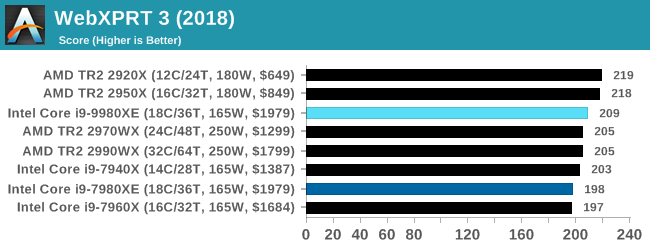
WebXPRT 2015: HTML5 and Javascript Web UX Testing
The older version of WebXPRT is the 2015 edition, which focuses on a slightly different set of web technologies and frameworks that are in use today. This is still a relevant test, especially for users interacting with not-the-latest web applications in the market, of which there are a lot. Web framework development is often very quick but with high turnover, meaning that frameworks are quickly developed, built-upon, used, and then developers move on to the next, and adjusting an application to a new framework is a difficult arduous task, especially with rapid development cycles. This leaves a lot of applications as ‘fixed-in-time’, and relevant to user experience for many years.
Similar to WebXPRT3, the main benchmark is a sectional run repeated seven times, with a final score. We repeat the whole thing four times, and average those final scores.
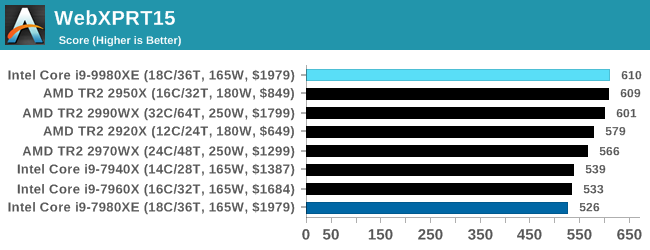
Speedometer 2: JavaScript Frameworks
Our newest web test is Speedometer 2, which is a accrued test over a series of javascript frameworks to do three simple things: built a list, enable each item in the list, and remove the list. All the frameworks implement the same visual cues, but obviously apply them from different coding angles.
Our test goes through the list of frameworks, and produces a final score indicative of ‘rpm’, one of the benchmarks internal metrics. We report this final score.
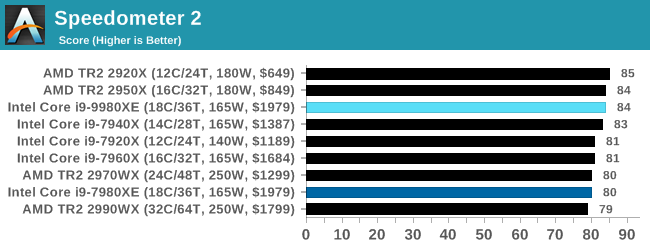
Google Octane 2.0: Core Web Compute
A popular web test for several years, but now no longer being updated, is Octane, developed by Google. Version 2.0 of the test performs the best part of two-dozen compute related tasks, such as regular expressions, cryptography, ray tracing, emulation, and Navier-Stokes physics calculations.
The test gives each sub-test a score and produces a geometric mean of the set as a final result. We run the full benchmark four times, and average the final results.
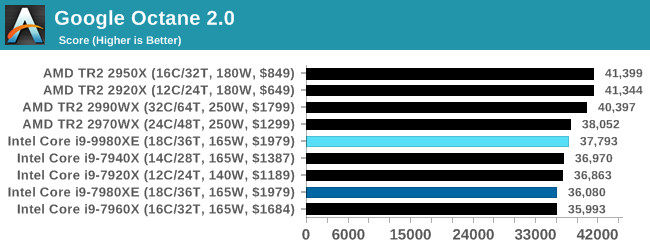
Mozilla Kraken 1.1: Core Web Compute
Even older than Octane is Kraken, this time developed by Mozilla. This is an older test that does similar computational mechanics, such as audio processing or image filtering. Kraken seems to produce a highly variable result depending on the browser version, as it is a test that is keenly optimized for.
The main benchmark runs through each of the sub-tests ten times and produces an average time to completion for each loop, given in milliseconds. We run the full benchmark four times and take an average of the time taken.

3DPM v1: Naïve Code Variant of 3DPM v2.1
The first legacy test in the suite is the first version of our 3DPM benchmark. This is the ultimate naïve version of the code, as if it was written by scientist with no knowledge of how computer hardware, compilers, or optimization works (which in fact, it was at the start). This represents a large body of scientific simulation out in the wild, where getting the answer is more important than it being fast (getting a result in 4 days is acceptable if it’s correct, rather than sending someone away for a year to learn to code and getting the result in 5 minutes).
In this version, the only real optimization was in the compiler flags (-O2, -fp:fast), compiling it in release mode, and enabling OpenMP in the main compute loops. The loops were not configured for function size, and one of the key slowdowns is false sharing in the cache. It also has long dependency chains based on the random number generation, which leads to relatively poor performance on specific compute microarchitectures.
3DPM v1 can be downloaded with our 3DPM v2 code here: 3DPMv2.1.rar (13.0 MB)
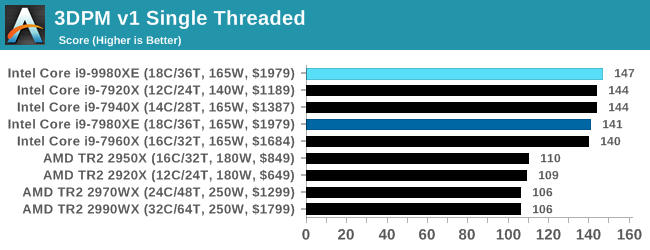
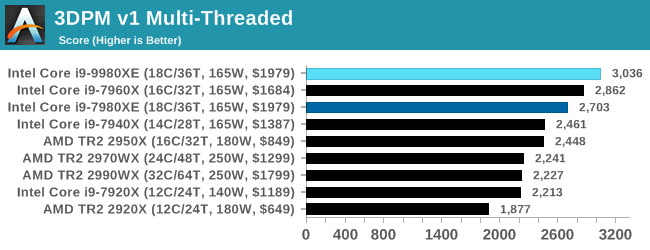
x264 HD 3.0: Older Transcode Test
This transcoding test is super old, and was used by Anand back in the day of Pentium 4 and Athlon II processors. Here a standardized 720p video is transcoded with a two-pass conversion, with the benchmark showing the frames-per-second of each pass. This benchmark is single-threaded, and between some micro-architectures we seem to actually hit an instructions-per-clock wall.
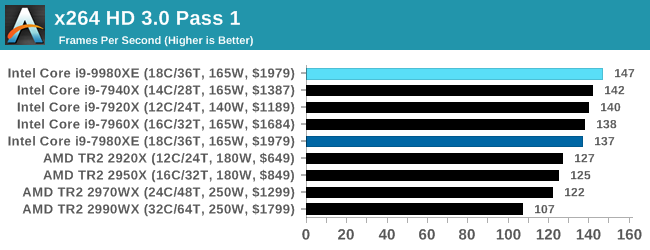
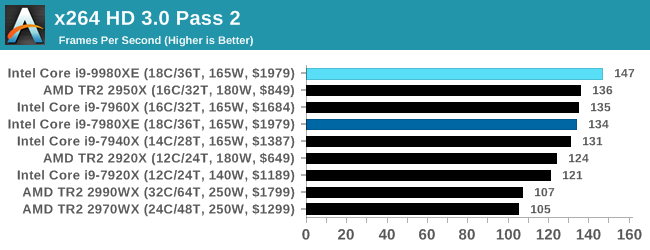










143 Comments
View All Comments
imaheadcase - Tuesday, November 13, 2018 - link
Yah because you don't do anything intensive with the jobs you have, of course you would use laptops or whatever mobile. But the reality is most people would use desktops because simply faster to get stuff done, and more powerful.BYOD fyi is not like that for most companies..
imaheadcase - Tuesday, November 13, 2018 - link
..and if you are doing anything intensive with laptops..that just means company you work for is behind the curve and just being cheap and not fork out money for the right hardware.PeachNCream - Tuesday, November 13, 2018 - link
There are over 250K people on the payroll. There ARE desktop PCs around, but they are few and far between. I'm not going to get into an extended debate about this because it won't change anyone's perspective, but I do believe you've got a slight misconception about the usefulness and flexibility of portable computer hardware. A simple look at the availability of desktops versus laptops should be enough to make it obvious, for most people, computer == laptop these days.Spunjji - Tuesday, November 13, 2018 - link
You're eliding the difference between "convenient and sufficient" and "as powerful as anyone needs".I'll absolutely grant that if you're only going to have one system for doing your work and you move around a fair bit, then it absolutely makes sense to have that system be mobile, even if you lose a bit of edge-case performance.
For people doing /serious/ GPU grunt work something like an XPS 15 is going to provide between 1/2 and 1/3 of the power they could get with a similarly priced desktop. That compromise doesn't make any sense for someone whose job does not require mobility.
So sure, notebooks are better than ever for a large number of people. Doesn't make desktops and HEDT chips functionally irrelevant for businesses, though. If you can really use 18 cores for the work you're doing then being provided with an XPS 15 will be, at best, a sad joke.
Ratman6161 - Tuesday, November 13, 2018 - link
Any laptop is essentially on a different planet than any of the processors covered in this review (doesn't matter if we are talking Intel or AMD).1. If it is possible to do your work on a laptop (which I am myself at this very moment) then you (and me) are not the target audience for these CPU's. In fact, I'm not entirely sure why you even bother to read or comment on the story?
2. If you have to ask if you need it, you don't need it.
3. If you have to think more than about 1 second to make a decision between one of these and a laptop, then you don't need it.
4. If you do need one, then you already know that.
Most people don't need one, including me. I read these things because the technology is interesting and because I find it interesting what others might be doing. I don't really feel any need to insist that others need what I need and could not possibly need anything else.
PeachNCream - Wednesday, November 14, 2018 - link
So a differing opinion than yours should mean that someone not read an article or comment on it. That appears to be nothing more than a self-protective mechanism intended to erect a bubble in which exists nothing more than an echo chamber filled with your own beliefs. That's hardly a way to integrate new thinking, but I do understand that a lot of people fear change in the same way you do.Kilnk - Tuesday, November 13, 2018 - link
"But the reality is most people would use desktops because simply faster to get stuff done, and more powerful."See, that's the problem with your reasoning. You assume that most people need power when they do not. The reality is that the majority of people who need to use computers for work do not need to do rendering or any kind of intensive task. So no, most people don't use desktops nor would they want to use desktops given the opportunity. They use laptops.
FunBunny2 - Tuesday, November 13, 2018 - link
"Now we live in a BYOD (bring your own device) world where the company will pay up to a certain amount (varies between $1,100 and $1,400 depending on funding from upper echelons of the corporation) and employees are free to purchase the computer hardware they want for their work. There are no desktop PCs currently and in the past four years, only one person purchased a desktop in the form of a NUC. "The Man's advantage to the Worker Bees using laptops: their always 'on the job'. no time off. as close to slavery as it's legal to be. some smart folks are truly stupid.
PeachNCream - Tuesday, November 13, 2018 - link
"The Man's advantage to the Worker Bees.." (just quoting because of the lack of continuing indents in Anandtech's 1990's-era comment system)I think that's a bit of a stretch in our case. My division doesn't do on-call and we strictly prohibit our lower tier managers from tapping employees outside of their normal work hours. Even checking company e-mail outside of work hours is against posted (and enforced) policy. If we must, due to emergencies, they absolutely have to be compensated for the time regardless of whether or not they are hourly or salaried workers. I haven't seen an "emergency" that couldn't wait until the next day so that policy has not been put into use in at least the last five years. Computational mobility is no excuse to allow invasions into off-the-clock time and I for one won't allow it.
jjjag - Tuesday, November 13, 2018 - link
I hate to admit it but PNC is right. Super-high-powered desktops are an anachronism. If you need REAL horsepower, you build a server/compute farm and connect to it with thin-client laptops. If you are just doing software development, the laptop cpu is usually good enough.This is especially true of single socket monsters like these HEDT chips. The only reason they exist is because gamers will pay too much for everything. It's nothing more than an expensive hobby, and like all hobbies at the top end is all "want" and very little "need". The "need" stops somewhere around 6 or 8 cores.
It's exactly the same as owning a Ferrari and never taking it to the track. You will never use more than 20% of the full capabilities of it. All you really need is a Vette.